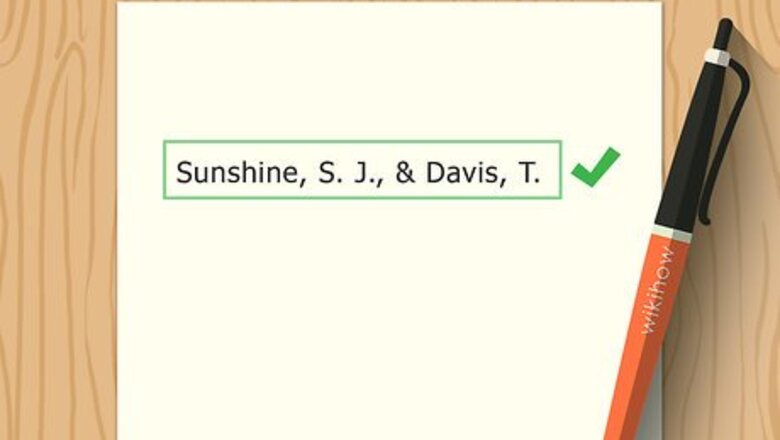
views
Citing 2 to 6 Authors
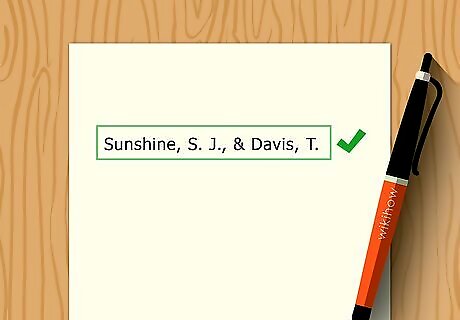
List all authors by last name and first and middle initials. Generally, if a work has multiple authors you must list all of their names in the citation entry on your reference list. In APA style, you list the last name followed by a comma, then the author's first initial and middle initial. For instance, an author named Francis Leanne Montgomery would be listed as "Montgomery, F. L." If the author's middle name or initial is not provided, just use their first initial. For example, "Powell, J." Separate names of authors with commas. Check to make sure you have a comma after each last name and after each set of initials. For example: "Sunshine, S. J., Summers, P. T., & Autumnwood, S."
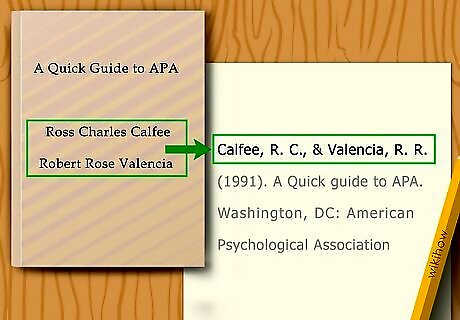
Order the authors' names as they appear on the title page. When you have multiple authors, the order of their names typically is negotiated by the authors themselves. Keep the order intact as chosen by the authors. Alphabetize entries in your reference list by the last name of the first author listed.
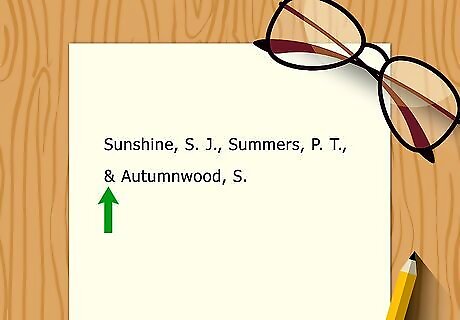
Include an ampersand before the last author's name. In your reference list, use an ampersand (&) rather than spelling out the word and to indicate the end of your list. If everyone listed is an editor, follow the last name with a comma and the abbreviation "eds." The ampersand is always preceded by a comma. For example: "Sunshine, S. J., & Davis, T."
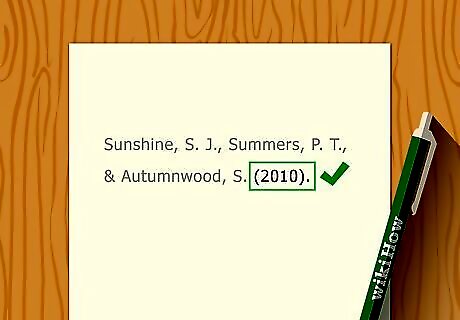
Provide the year of publication in parentheses. The year the work was published follows immediately after your list of names in parentheses. Then, add a period outside the closing parenthesis. For example: "Sunshine, S. J., Summers, P. T., & Autumnwood, S. (2010)." There is no comma between the last author's initial and the opening parenthesis.
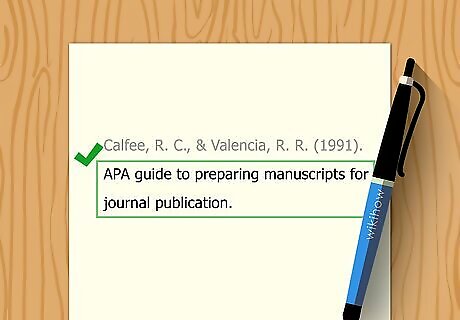
Include the complete title of the work. After the date, your citation next must let your readers know the complete title of the work. Capitalize the title just as you would a sentence. This means often only the first word is capitalized. If the work also has a subtitle, include it after a colon. You'll also capitalize the first word of the subtitle. The title may be in italics, depending on the type of work you're citing. This stays the same regardless of the number of authors. For example, a book title would be italicized, but an article in a scholarly journal would not be italicized.
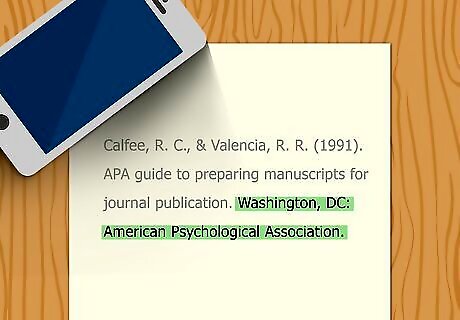
Finish by noting the publication information. The rest of your citation tells your readers where the work was published. The type of information included depends on the nature of the source and how you retrieved it. For example, if you're citing a book written by 3 authors, your citation might be "Calfee, R. C., & Valencia, R. R. (1991). APA guide to preparing manuscripts for journal publication. Washington, DC: American Psychological Association."
Citing 7 or More Authors
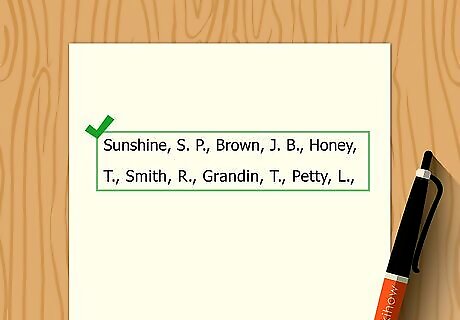
List the last names and initials of the first 6 authors. A citation should never have more than 7 names. If you're citing a work with 7 or more authors or editors, you'll have to leave out some of the names in an APA citation. Keep the names of the authors in the order they are listed on the title page of the book.
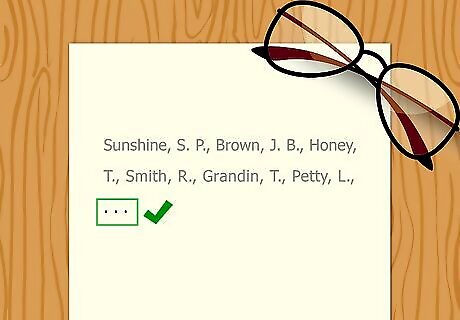
Place an ellipsis after the sixth author's name. Follow the sixth author's name with a comma, and then use an ellipsis to indicate there are additional authors. Make sure you include a comma after the sixth author's name. You don't need a comma after the ellipsis. Check your word processing app for an ellipsis style function – it looks like it's just a string of 3 periods, but they are spaced further apart than regular periods.
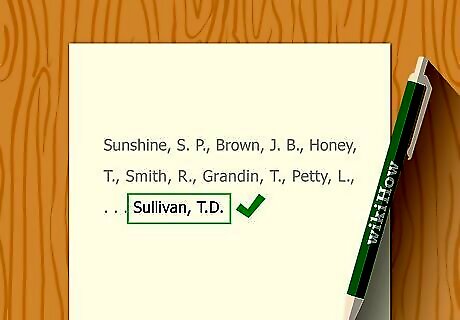
Close with the last author's name. Follow the regular rules to include the final author's name after the ellipsis. Put a comma after the last name followed by the author's initial. For example: "Sunshine, S. P., Brown, J. B., Honey, T., Smith, R., Grandin, T., Petty, L., . . . Sullivan, T.D."
Add the publication year in parentheses. The next bit of information to include is the year the work was published. Put it in parentheses and add a period after the closing parenthesis. For example: "Sunshine, S. P., Brown, J. B., Honey, T., Smith, R., Grandin, T., Petty, L., . . . Sullivan, T.D. (2015)."
Note the full title of the work. Use title capitalization, meaning that only the first word of the title should be uppercase. Put the subtitle, if applicable, after a colon. For instance: "Sunshine, S. P., Brown, J. B., Honey, T., Smith, R., Grandin, T., Petty, L., . . . Sullivan, T.D. (2015). Creating APA citations for multiple authors."
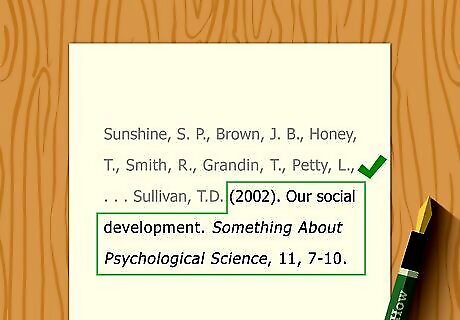
Include the publishing information last. Finish by noting the place of publication along with the publisher. Put a colon between the two and a period at the end. For instance: "Sunshine, S. P., Brown, J. B., Honey, T., Smith, R., Grandin, T., Petty, L., . . . Sullivan, T.D. (2015). Creating APA citations for multiple authors. London: Johnson Publishing Group."
Writing In-Text Citations
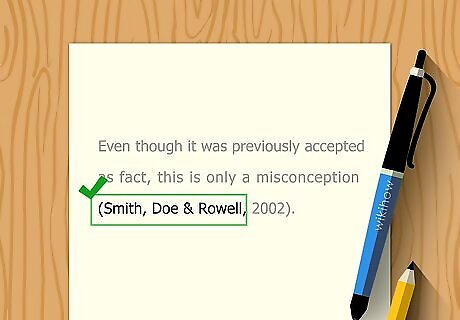
List the last names of the authors. For your in-text citation, you still need to list every name the first time you cite to that particular source. Separate the authors' names by commas, including a comma before the ampersand that follows the next-to-last author's name. Use an ampersand (&) before the last author's name if you are doing a parenthetical citation. If you're incorporating the authors' names into your text, you would spell out the word "and." For example: "(Sunshine, Clark, & Lane, 2010)" or "This truth is reflected in the work of Sunshine, Clark, and Lane." If the work has more than 5 authors, you would simply list the last name of the first author, followed by the Latin abbreviation "et al." For example: "(Lane et al., 2014)".
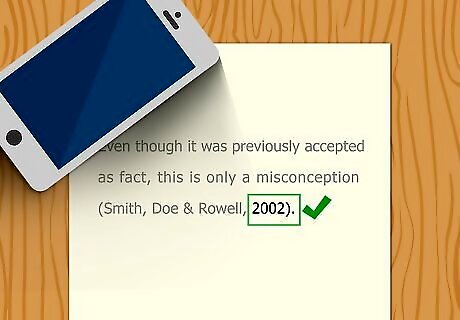
Follow the names with the year of publication. As with any citation in APA style, the year of publication always follows the names of the authors or editors. The year of publication is not in italics. For example, a parenthetical in-text citation might read "(Sunshine, Summers, & Autumnwood, 1984)."
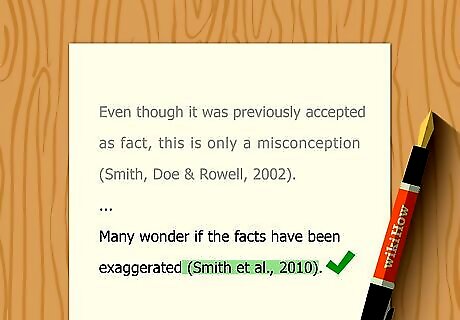
Use the abbreviation "et al" in subsequent citations. Once you've listed all the authors' names out once, there's no need to continue doing it repeatedly. The Latin abbreviation "et al" lets your readers know that there is more than one author of the work. For example: "(Sunshine et al., 2010)."
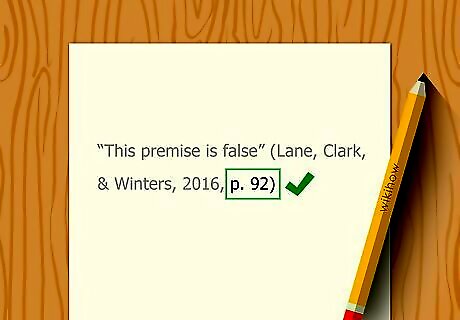
Include the page number for direct quotes. If you're merely paraphrasing a reference, the authors' last names and the year of publication are all that is required. For direct quotes, however, you must point your reader to exactly where those words appear. For example: "(Lane, Clark, & Winters, 2016, p. 92)."
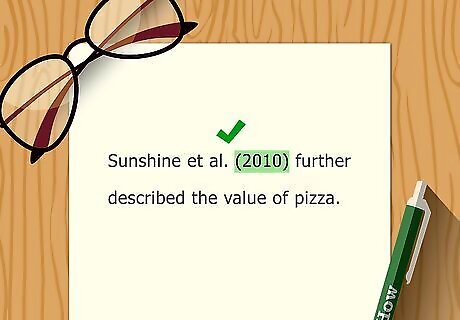
Provide the date in parentheses when the authors' names appear in the sentence. Sometimes you'll want to list the authors' names directly in your sentence. With multiple authors, list all of their last names, separated by commas, and then add the year of publication in parentheses. Use the word "and" immediately before the last author's name. Make sure you have a comma after the next-to-last authors' name as well. For example: "According to Sunshine, Summers, and Autumnwood (2010), pizza is a great afternoon snack." If there are more than 5 authors, use the first authors' name followed by the Latin abbreviation "et al." when you mention them in your text, just as you would in the parenthetical citation. For example, "Sunshine et al. (2010) further described the value of pizza."

















Comments
0 comment